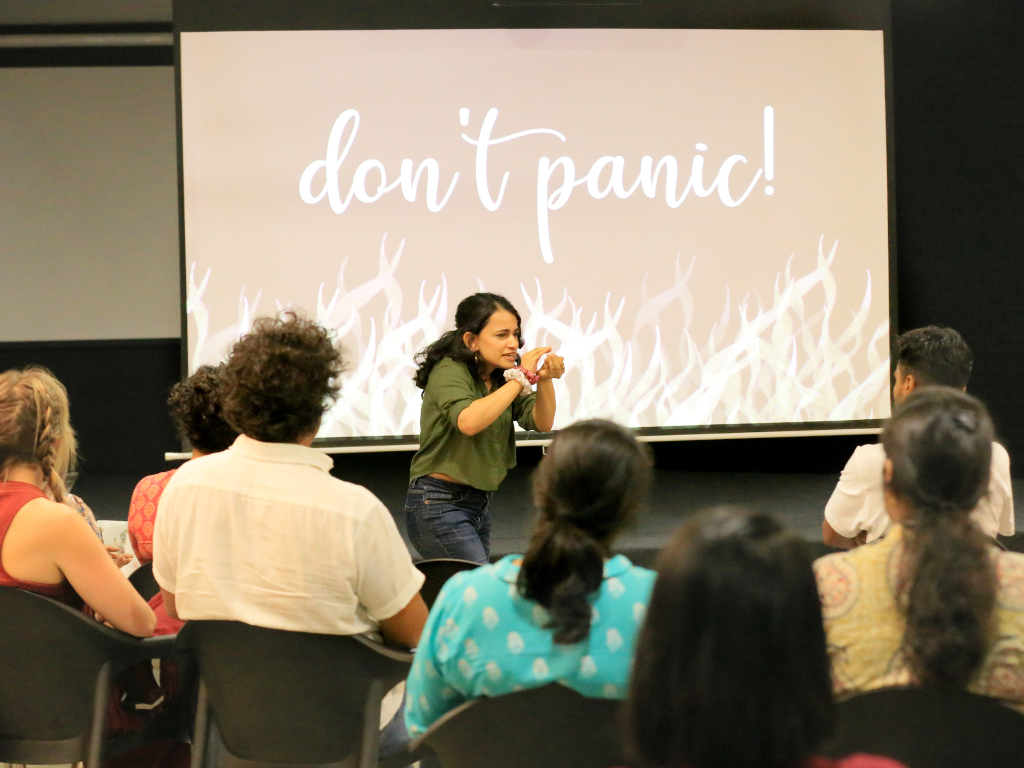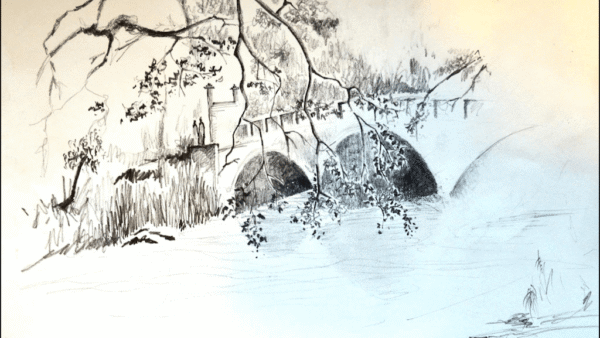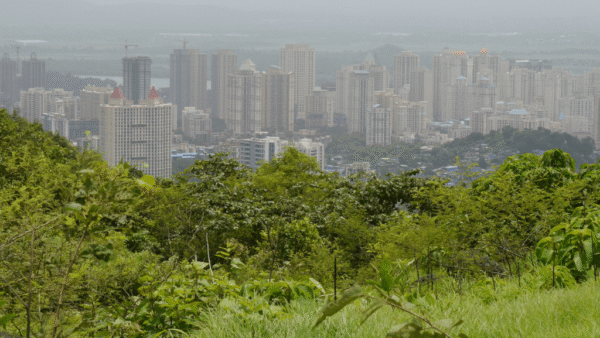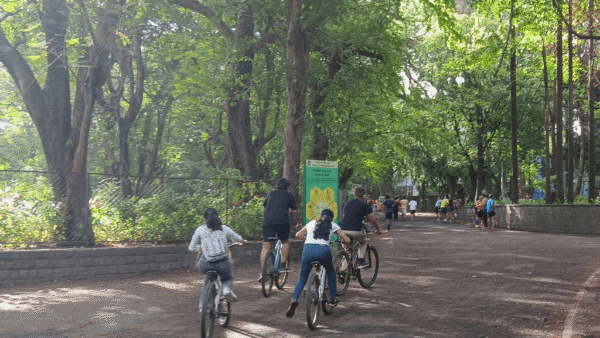The play Plan B/C/D/E starts off with a discussion about climate anxiety, a term that solo performer Meghana relates to her own experience of living in a world reeling under the impact of climate change. But she has plans to offer. In a satirical, interactive, and thought-provoking piece of theatre about the climate crisis facing India’s cities, Meghana focuses on Mumbai and the sea-level rise projected to submerge the island city.
In her performance, she quietly dispels people’s delusion that climate change is what the future generations will experience and drives home our lived realities. She deftly links record breaking summers, intense and unseasonal rainfall events, and unabated pollution to climate change. Using relatable quips, modern technology, and a few solutions from history, Meghana takes her audience from being sceptical or untouched about climate change to actively seeking solutions.
An interactive play on climate change signifies, in a sense, the shift from the news-driven climate communication. Films, games, stand-up comedy shows, and fun-based educational initiatives make up the creative forms of climate communication. From the climate solutions-oriented games developed in Bengaluru to an experiential animated film based in Mumbai’s Govandi slum rehabilitation area and stand-up comedians who roast governments on air pollution, the creative forms of communicating the climate crisis are gaining ground.
In doing so, climate communication is reaching some of the people it affects the most – the marginalised people with little access to the weighty studies and research reports, and fewer tools to interpret them. This has helped to demystify the complex and complicated – often inaccessible – aspects of climate change for many. With artists, researchers and educators finding creative ways to talk about climate change, the focus moves away from jargon like net zero emissions to the impact of climate change on the lives, health, and livelihoods of people.
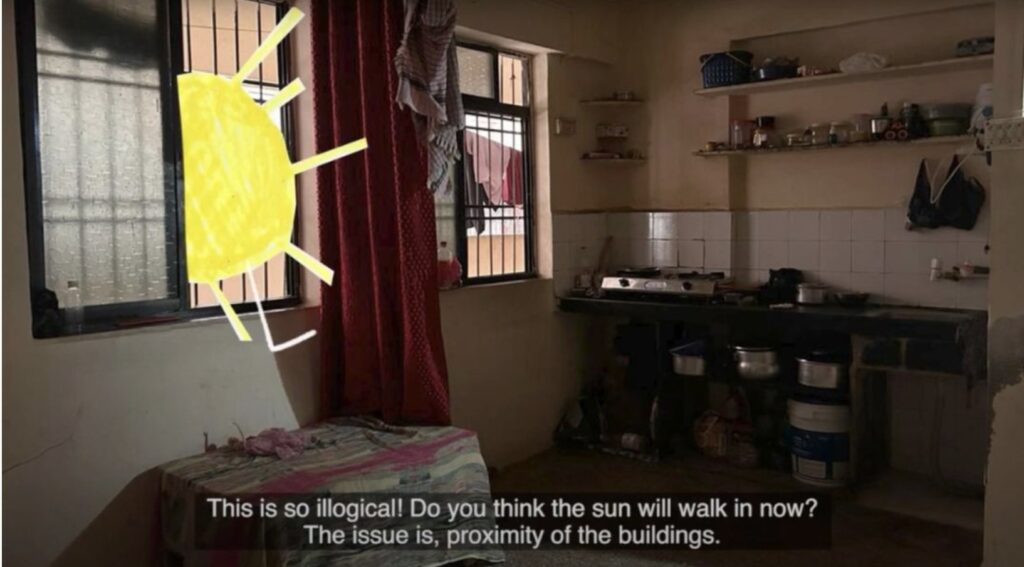
Performance devices such as satire, humour, anxiety and even grief are paving the way to talk about climate change in ways starkly different from that of the mainstream news by centering people’s lived experiences, and empowering people to break the barriers of climate science and English. It’s not news or creative forms; both are needed. And the new forms are enriching climate conversations.
How plays and comedy bring about climate consciousness
Making climate communication innovative often starts with a search for a new idiom itself. As Meghana sat down to write her play, she dug deep into the number of mythologies of floods that exist. And thought about the floods in Mumbai, about its possible submergence. What’s Plan B, ask many. In case Plan B too did not work, what would be Plan C, D, E she thought. The tone of the play has evolved in the last six years but the theme and approach remain the same.
Meghana brought a rarely used term– climate grief – upfront after finding it in the news stories of the funeral for the Okjökull glacier in Iceland. She added it to her play and realised it was a useful theatrical device. “Even if not about the climate, we’ve all looked at something, someone, a relationship, a moment of our lives and thought that it’s never going to be this way again,” she said to Question of Cities. Hinging on this and similar tools, her play makes her audience care about climate change.
However, it is often a delicate balance. While conveying climate anxiety, she brings in themes such as the Covid-19 pandemic and the genocide in Gaza, but tries to not overwhelm people. “There’s no climate justice without social justice,” she says. Plan B/C/D/E has completed nearly 40 shows including at the prestigious Durbar Hall of The Asiatic Society of Mumbai. She uses news for information about heat and migration but uses emotions to appeal to her audience. “We are better at remembering our emotions than remembering facts,” she explains and adds that creative non-news forms like hers use similes, metaphors, analogies, and humour.
The play gets “co-written” with her audiences based on their responses most pertinent at the time of the performances. For instance, air pollution was a huge part of her February show in Mumbai when the air was barely breathable. Rimsha Minocha, a documentary filmmaker who saw the play in November last year, says, “It was a slap in the face for me. You know these issues exist but the performance makes you realise they are real. The interactive format is humorous and engaging, and you start thinking about solutions, what you can do.”
Comedy about climate
Another creative form dwelt on air pollution too. Mumbai saw its first ever stand-up comedy show with jokes about air pollution this February when Asar and DeadAnt Co brought together 25 comedians in a show called Laughs per minute. The Air Quality Index had touched a high of 308 in Worli on December 26, 2024, and remained ‘poor’ or ‘moderate’ in other areas of Mumbai through the winter months.[1]
Comedy made the residents laugh but in a manner that would make them think. It started when Brikesh Singh reflected on the incisive commentary that many comedians had on issues of the day but no jokes on air pollution. Singh, chief of communications and engagement, Asar, who dabbles in stand-up comedy too, had worked on the issue in Delhi earlier. He took the initiative. The first show was in Delhi in 2023 followed by the latest edition in Mumbai this year.
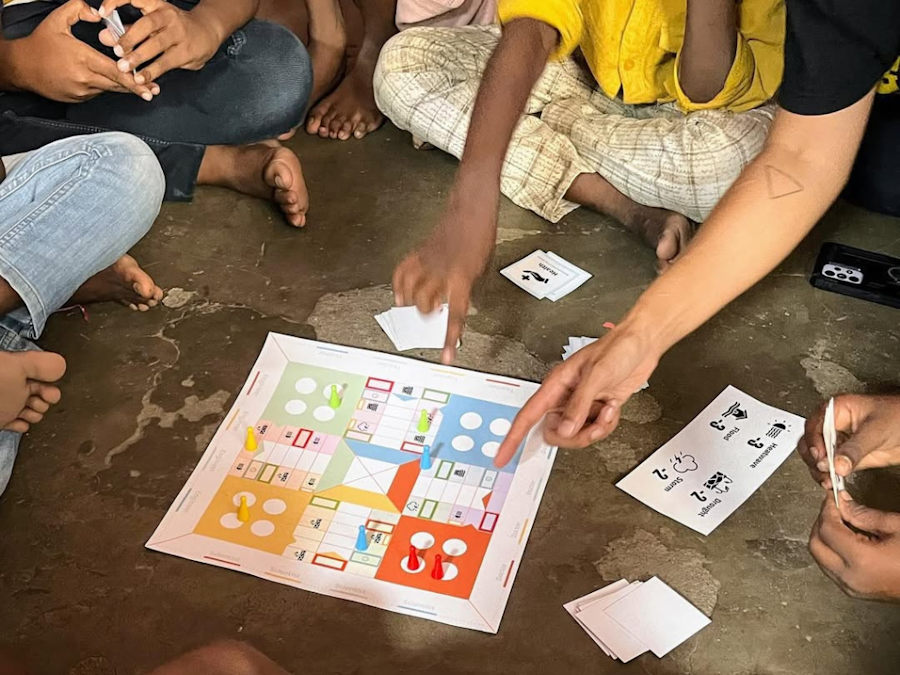
Photo: Heat in Bangalore
Singh brought news about poor air into everyday conversations through humour by tapping into the abilities and influence of stand-up comedians. The videos from 2023 are still trending on social media two years later in 2025, Singh said. Gradually, he saw popular comedians like Azeem Banatwalla also take up climate and air pollution issues. “We managed to crack open an entirely new medium but this is just scratching the surface,” says Singh.
Language no barrier
In Natwar Parekh Compound of suburban Mumbai’s Govandi, a slum rehabilitation colony, residents may not know climate vocabulary but they are aware of the deteriorating impact of climate change on their lives. They developed their own understanding and vocabulary. The film Gutter ki Macchli, by director Natasha Sharma, captures the drawings and poetry by the children, youth and women that reflects their struggle against climate events.
Their first-hand experience more than makes up for their unfamiliarity with climate terminology. The lack of sunlight in their matchbox homes, the dearth of open spaces, growing up or growing old near Asia’s largest dumping ground, the Deonar landfill, are brought to life with animation. Using the Arts4Resilience grant, Sharma collaborated with Elementree to conduct 12 arts-based workshops, recorded more than 24 hours of conversations during them, and used the poetry and artwork in her film as the climate vocabulary of Govandi. “This is what arts-based research can do, bring out a localised reality that’s neglected in the popular climate communication,” she says.
Typically, when asked to draw scenery, children drew the sun, mountains, a boat in a river, and a bungalow. When Sharma prodded them to look around, other visuals emerged—buildings tightly packed into the landscape, the sun hidden because the children said they never saw it, the river turned into a gutter they saw every day, and the boat replaced by garbage. “What remained in the gutter were the fish, that’s the title of the film,” says Sharma.
The lived experience of flood here is walking amidst garbage-laden water, losing chappals in the process, and then seeing chappals along with other flotsam clog the drains that cause more flooding in the rain. Sharma even came across a drawing of a person holding onto a roof while the flood water swirled below. “With drawings and poetry, you start to see comedy in tragedy. And children started to visualise this humour too.’’ In Govandi, such humour is a language in itself.

Photo: Asar
Here, the women share their daily struggles with extreme heat, floods and air pollution with humour too. “If I had asked them flatly about climate change, all this would not be in the film,” she says because glaciers melting and sea-level rising are too distant from their reality. Parveen Shaikh, who features in the film, says that the community knows the impact of heat which causes fatigue, dizziness, and irritability. “Hum baat karte the ki mausam bhi insaan ki tarah badal raha hai, phir humne seekha ki isse ‘climate change’ kehte hai. (We used to say that the weather is changing like people, and then we learnt that this is called climate change),” she says, “No one has documented with us in this manner.”
Finding climate solutions through play
Whether the good old Ludo or new board or card games, climate communication has found expression in play too. These games are centred on climate action, focusing on the players’ local environment, as the games by Ashoka Trust for Research in Ecology and the Environment (ATREE) show. “The idea was to make it as relatable to children and youth of various backgrounds as possible,” says Dr Manan Bhan, researcher at ATREE who helped develop card games.
The first game, representing a year, asks players to overcome the seasonal and unseasonal challenges like heat and rainfall experienced in Bengaluru and suggest preparation. The second is about building sustainable neighbourhoods which, for children from disadvantaged backgrounds, means basic facilities. “Players have to use infrastructure like public transport, health facilities, and waste collection that should be part of a neighborhood,” explains Dr Bhan. The third game primes players to think about climate solutions through prompts rooted in their social environment.
All the games can be localised to suit languages, locations and hazards. “Climate disasters can be added or subtracted. Mumbai has floods or, more recently, cyclones and the game could be played in Marathi,” says Dr Bhan. ATREE partnered with Association for Promoting Social Action (APSA) to develop the games and facilitate sessions with children. There have been requests for more game sets and they are available in English and Kannada.
Climate knowledge products of people
In December 2022, Mumbai’s Urban Art Festival held at Sassoon Docks brought climate change into popular discourse through installations and performances besides the usual technique of panel discussions. The festival included myriad stories and installations from the city, and the world over, in a variety of art forms striving to raise questions about climate impacts in ways accessible to people.[2]
The exhibit “Sea never dies” by Ghanaian artist Serge Attukwei Clottey, a sheet of gold sequins made of repurposed plastic oil cans that block waterways in a striking blue-coloured room resembling the sea, resonated with many. French artist Rero’s work was about city-dwellers acknowledging the sea and coming face-to-face with their narcissism and hunger that kills it. Dennis Fabian Peter’s mixed media installation of innumerable tube lights and their rhythmic switching on and off mimicked sea waves. Neha Abhay Dalvi, an architect who attended the festival, remembers the large amount of plastic on display through art. “It brings in the realisation that what we are consuming is contributing to climate change,” she says.
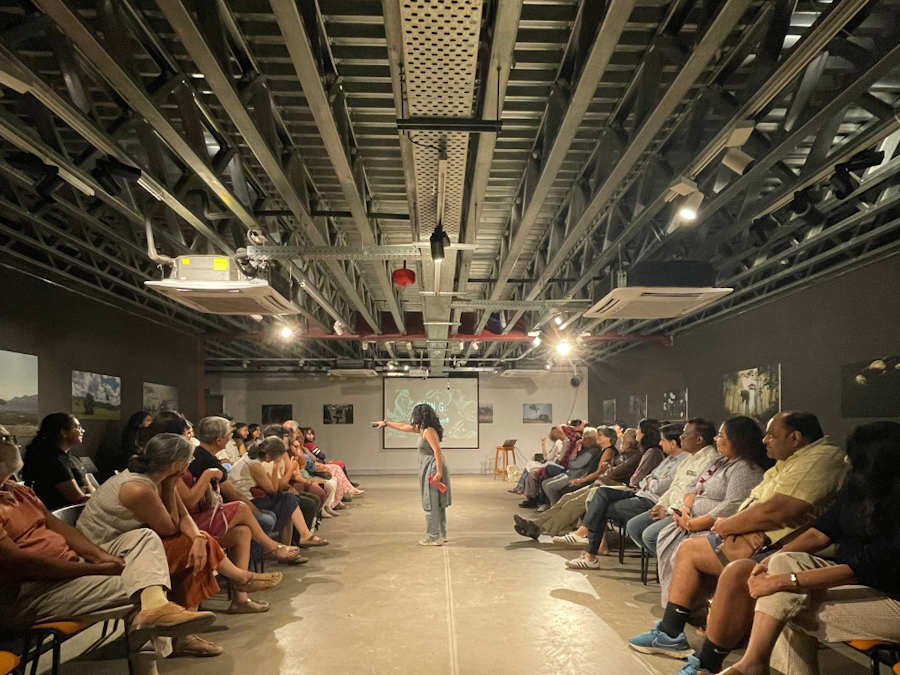
Photo: Tafreewale
The creative forms travel across languages. Sharma was fascinated to see someone explain her film in Tamil or the response it got from the audience in Bengaluru. Its resonance transcended languages and came from the experiences of people miles away from Govandi. These forms are valuable beyond climate-related news. They are, according to practitioners, knowledge products that lean into local languages and lived realities to make climate conversations possible among those who do not know English, the dominant global language for such communication. As Sharma says, using creative forms and strategies – perhaps even in journalism–is itself climate resilience and opens up avenues to know about the social resilience of communities.
For comedians, the use of data, science or jargon is tangential; the purpose is to get people talking through humour. For example, how would a street vendor describe pollution vis-à-vis scientific reports about particulate matter and mortality? The aim, Singh says, is to raise awareness levels so that the next time they come across hard news on climate change, they will engage with it. Comedians’ videos have gone viral. For instance, Punit Punia’s comedy about Mumbai’s air pollution went viral in Kerala and the issue was picked up by a news organisation.
Climate communication coming out of its traditional moulds of news and academic writing has helped many, who were excluded from these domains, to join the conversations. And this is just the beginning.
Jashvitha Dhagey is a multimedia journalist and researcher. A recipient of the Laadli Media Award consecutively in 2023 and 2024, she observes and chronicles the multiple interactions between people, between people and power, and society and media. She developed a deep interest in the way cities function, watching Mumbai at work. She holds a post-graduate diploma in Social Communications Media from Sophia Polytechnic.
Cover photo: Tafreewale

